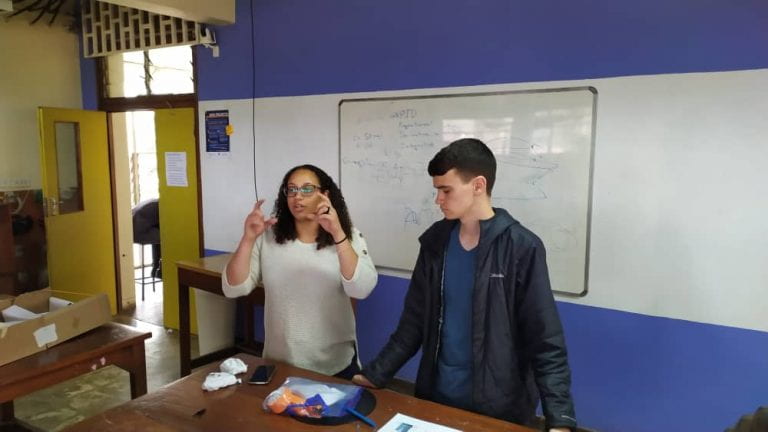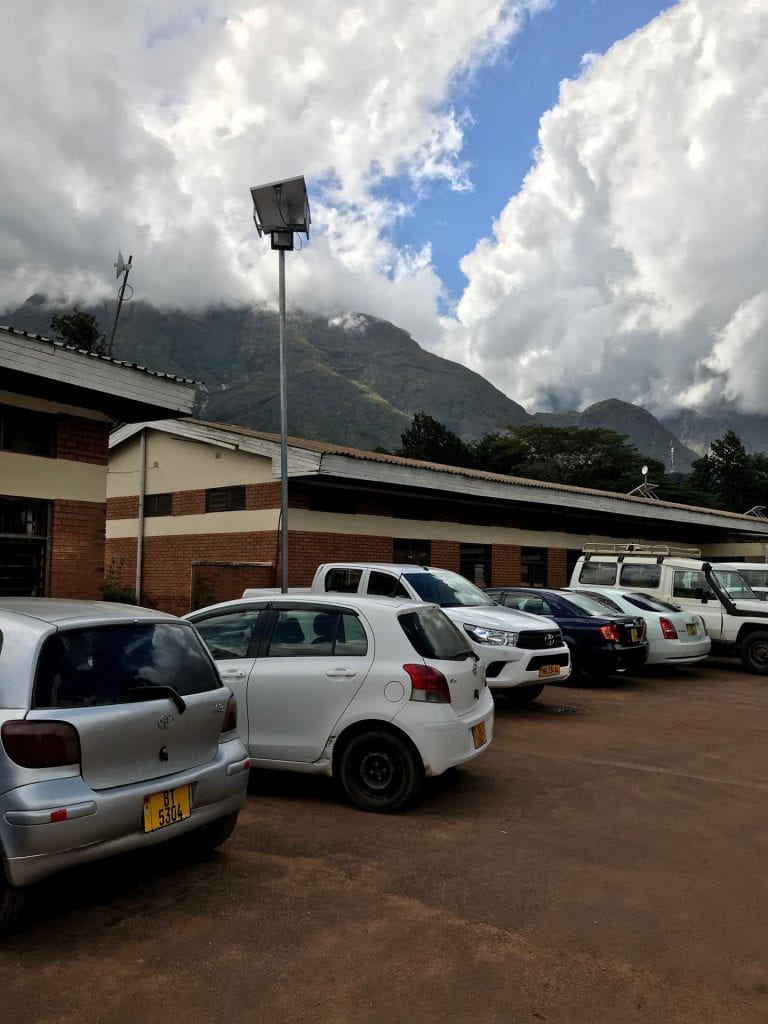Every morning starts with a 15 minute bus ride from Kabula to Queen Elizabeth Central Hospital, where all 11 interns and several other doctors and students from the lodge crowd into a van the size of the Mystery Machine (I’ve thought really hard and this is the best description I can come up with). From the hospital, we then walk along the busy streets of Blantyre to the campus of the Polytechnic…
June 10th – First Day at the Poly
After receiving a warm welcome from the Dean of Engineering, we split up into teams for a mini design challenge: make a ping pong ball take exactly 30 seconds to fall a height of one meter. The activity was surprisingly difficult, with even the most successful of teams only able to reach a fall time of 15 seconds. Overall, the activity provided a preview of what the next 6 weeks might look like – building off of each other’s creativity with a limited amount of resources, ultimately getting one step closer to a solution.
After lunch, we were given an overview of the engineering design process by Dr. Ng’anjo. I recognized his face from when he taught some lessons in my engineering design course back at Rice, and he recognized me as well! It was cool to talk to him again and be a part of his lecture. Before hand, our table was talking with him and somehow the topic of food came up. Having visited all of our countries, he made the claim that the staple of Malawian food is nsima, Tanzanians love their maize, and Americans put cheese on everything! I hadn’t really noticed this before, but it really is true… over lunch I had shared with everyone my favorite snack from back home: Cheez-Its.

June 11th – Tackling Arduino and Project Assignments
The world of computer programming and electrical engineering has always been super intimidating to me. Having not taken any classes in these fields yet, this was one of my main insecurities heading into the internship. But coming out of this morning, I felt like I had the knowledge and skillsets to approach any of the design challenges we may face in the next few weeks. Andrew, a lecturer at the Poly, had lead us in a hands-on workshop where we learned the basics of manipulating an Arduino and writing C++ code. While it may sound simple, I found the process of creating a flickering lightbulb so rewarding that I now feel excited to jump into this once-intimidating field.
Later in the day, we were given our main project assignments and developed questions to ask nurses on our hospital visits. Racheal, Betty, Rodrick and I will be working on the developing a Ballard Score training model to help nurses better identify the degree of prematurity for newborn babies.
June 12th – Mulanje District Hospital
On our first hospital visit, Betty and I joined the group traveling to Mulanje District Hospital. The drive was beautiful, filled with jagged mountains and the rolling hills of tea plantations. Not until we arrived at the hospital did we realize the sheer size of Mount Mulanje. The tallest points disappeared into the clouds and its width seemed to span on and on for miles – I still want to try and climb it, but we’ll see if that ends up happening.

Once inside the hospital we visited the maternity ward, where we met a nurse who had the time to answer some of our questions. We soon learned that the nurses were trained in the Ballard Score, but do not frequently use the signs in their day to day practice. The Ballard Score is also never performed in its entirety, and the chart itself is never used to calculate a final score for prematurity. This is because the full assessment takes 15-20 minutes to complete, and with as many as 20 babies being delivered per day, the understaffed nursing team is short on time. Instead of Ballard Score, they primarily use weight for determining whether or not a newborn is premature. This can be dangerous because weight is not a reliable measure of gestational age.
Overall, this hospital visit was a little discouraging. With only one nurse and so many teams asking questions, I sensed that we weren’t getting the full picture. It would have been nice to talk to more nurses and gather more perspectives, but their time is valuable. Ultimately, it is more important that their time be spent providing such critical care to their patients.
June 13th – Zomba Central Hospital
Our visit to Zomba began with a trip to the nursery, where we met three nurses who seemed excited to see us and willing to share their experiences. In comparison to Mulanje, these nurses described routinely using many physical signs of the Ballard Score but rarely ever any neuromuscular procedures. They even showed us a paper with the full assessment chart, but similar to Mulanje, a full Ballard Score is never calculated.
One of the most interesting responses we got from the nurses came when we asked why this was. Like at Mulanje, the nurses cited time as a major constraint, but they also spoke to an instinct they had developed after years and years of working in the hospital. When asked to elaborate on what this instinct was, the nurses ended up describing several of the physical signs of the Ballard Score: skin, lanugo, and breast specifically.
June 14th – Ice Cream for Lunch
Back at the Poly, all of the project teams met up and compiled their findings. Being that Racheal and Rodrick visited the two hospitals on different days than Betty and I, each of us had unique information obtained by asking different questions and interviewing different nurses. Going over it all, we began to find a direction for the rest of our project…
- Everywhere we visited, the nurses believed there was not enough time to perform a full assessment. The goal of this project should be incremental change. If we can add one more Ballard Score sign to a nurse’s skillset, their estimate of prematurity will improve in accuracy.
- Nurses find the current Ballard Score chart difficult to use and too tedious to fill out, instead, relying on their experience to estimate prematurity. An essential part of this project will also be helping nurses precisely match the physical signs they already use to specific degrees of prematurity.
If you made it to the end of this long blog post, thank you so much for reading! As a bonus, here’s some pictures of the amazing food we had on the last day of a busy week…


All is well from Malawi!
– Alex
